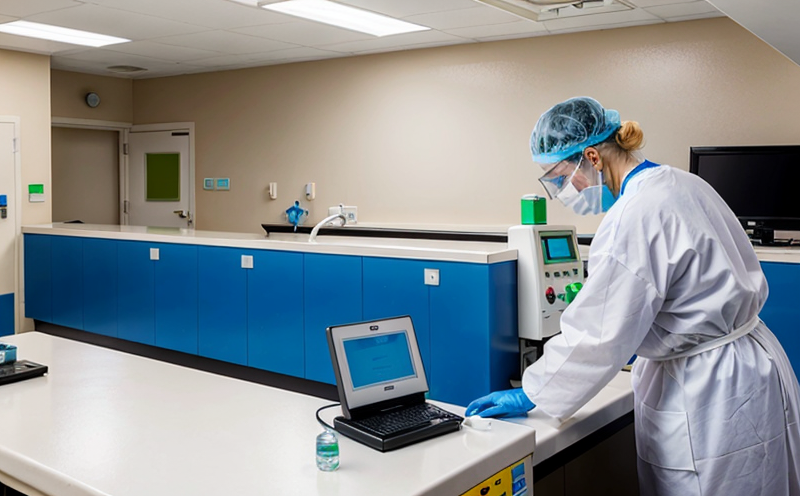Swab Testing for VRE (Vancomycin-Resistant Enterococci) in Healthcare Facilities
The presence of Vancomycin-Resistant Enterococci (VRE) in healthcare facilities poses significant challenges to patient care and infection control. Swab testing is a crucial tool used by laboratories to monitor the spread and prevalence of VRE within these environments. This test involves collecting samples from various surfaces, textiles, and healthcare workers' hands using sterile swabs.
The process begins with selecting appropriate sampling sites, which include high-touch areas such as door handles, bed rails, electronic equipment, stethoscopes, and other frequently touched objects. Specimens are then transported to the laboratory for processing according to stringent protocols outlined by international standards like ISO 16520-3:2018.
Once received at the lab, samples undergo rigorous preparation steps including transportation in suitable media (e.g., vancomycin-containing Mueller-Hinton agar) and incubation under controlled conditions. The use of specialized growth media ensures that even low-level contamination can be detected accurately.
The identification of VRE relies on colony morphology, biochemical tests, and antibiotic susceptibility testing. Laboratories typically employ methods compliant with guidelines provided by organizations such as the Clinical and Laboratory Standards Institute (CLSI) or European Committee for Standardization (CEN).
Post-identification, results are reported promptly to healthcare facilities using clear criteria defined by regulatory bodies like the Centers for Disease Control and Prevention (CDC). Reporting includes details about the location of positive findings along with recommendations for remediation actions.
Incorporating this testing into routine protocols helps maintain high standards of hygiene within hospitals and other healthcare settings. By identifying areas where VRE may be present early on, facilities can take proactive measures to prevent further transmission among patients and staff members.
Regular swab tests play a vital role in ensuring compliance with strict regulations aimed at reducing hospital-acquired infections (HAIs). They contribute significantly towards achieving the goals set forth by organizations dedicated to improving patient safety worldwide.
Applied Standards
The performance of swab testing for VRE must adhere strictly to relevant international standards. Key references include:
- ISO 16520-3:2018: Sampling and sampling strategy for the detection of pathogens in healthcare environments.
- Clinical and Laboratory Standards Institute (CLSI): Methods used for identification and susceptibility testing of microorganisms.
- European Committee for Standardization (CEN): Guidelines on hygiene practices within healthcare facilities.
These standards ensure consistency across different laboratories, enabling accurate detection and timely reporting of VRE incidents. Compliance with these guidelines is essential to maintaining credibility among stakeholders involved in monitoring hospital hygiene.
Adherence to such standards also facilitates data sharing between institutions, which enhances overall understanding of VRE prevalence trends over time. This collaborative approach contributes significantly towards developing effective strategies for managing this challenging pathogen.
Why Choose This Test
VRE poses a substantial risk to patients who are already compromised by illness or weakened immune systems. Regular swab testing serves multiple purposes:
- Patient Safety: Detects VRE early, allowing for prompt isolation and treatment.
- Infection Control: Helps identify hotspots for targeted cleaning efforts.
- Regulatory Compliance: Ensures adherence to local and international regulations regarding hospital hygiene practices.
- Data Collection: Provides valuable insights into the spread of VRE within facilities, aiding in evidence-based decision-making.
- Resource Optimization: Allows for efficient allocation of cleaning resources based on actual contamination levels.
By investing in this type of testing, healthcare providers demonstrate their commitment to providing safe and effective care while minimizing the risk of nosocomial infections. The investment also reflects a proactive approach towards addressing potential health threats before they escalate into larger outbreaks.
Use Cases and Application Examples
Swab testing for VRE finds application in several scenarios within healthcare facilities:
- New Facility Opening: A baseline assessment helps ensure new constructions meet hygiene standards from the outset.
- Post-Incident Investigation: Following an outbreak, swabs assist in determining the source and extent of contamination.
- Ongoing Monitoring: Routine tests provide continuous evaluation of cleaning protocols' effectiveness.
- Infection Control Programs: Integration into existing programs enhances overall performance metrics related to patient safety.
- Research Studies: Collaboration with academic institutions aids in advancing knowledge about VRE behavior and prevention strategies.
These examples illustrate how swab testing plays a pivotal role in safeguarding patients, staff, and visitors against VRE infections. Its versatility across various applications makes it an indispensable tool for maintaining optimal levels of hygiene within healthcare settings.





